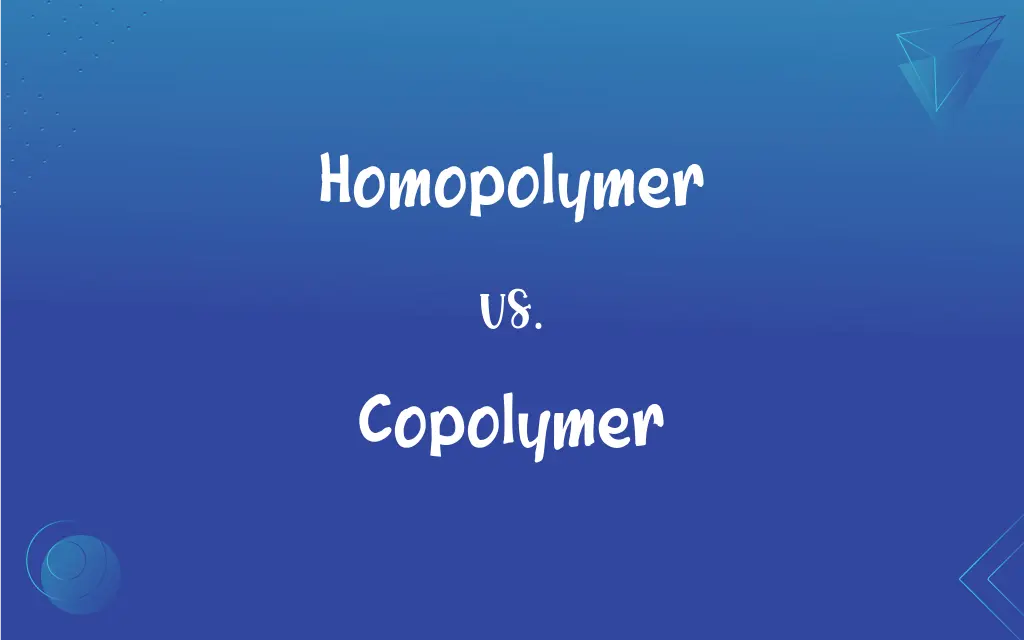Homopolymer vs. Copolymer: What's the Difference?
Edited by Janet White || By Harlon Moss || Updated on October 17, 2023
Homopolymers consist of one type of monomer, while copolymers contain two or more different monomers.

Key Differences
A homopolymer is a polymer made up of a single type of repeating monomeric unit. Copolymer, on the other hand, is formed from two or more distinct monomers.
Homopolymer has uniformity in its structure due to the repetition of only one type of monomer. Copolymer exhibits variation because of the combination of different monomers.
Homopolymer properties are often easier to predict due to their uniform structure. Copolymer properties can be tailored by varying the ratio and arrangement of the monomers.
Homopolymers often display properties inherent to their singular monomer. Copolymers can showcase a combination or enhancement of properties derived from its constituent monomers.
Homopolymers generally have less structural versatility compared to copolymers. Copolymers, with their multiple monomers, offer greater structural and functional diversity.
ADVERTISEMENT
Comparison Chart
Monomeric Units
One type of monomer.
Two or more different types of monomers.
Structural Uniformity
Uniform due to repetition of a single monomer.
Varied due to combination of different monomers.
Predictability
Easier to predict properties.
Tailored properties based on monomer ratio and type.
Versatility
Less versatile in structure and functionality.
Greater versatility due to multiple monomers.
Example
Polyethylene (from ethylene).
Nitrile rubber (from butadiene and acrylonitrile).
ADVERTISEMENT
Homopolymer and Copolymer Definitions
Homopolymer
A chain molecule consisting of identical monomeric units.
Polystyrene is a homopolymer made up of styrene units.
Copolymer
A macromolecule derived from the polymerization of multiple distinct monomeric species.
ABS is a copolymer consisting of acrylonitrile, butadiene, and styrene.
Homopolymer
A single-sequence polymer formed from only one type of monomer.
Polypropylene is a homopolymer formed from propylene monomers.
Copolymer
A polymer made up of two or more different types of monomers.
SBR is a copolymer of styrene and butadiene.
Homopolymer
A polymer derived from a single type of monomer.
Polyethylene is a homopolymer of ethylene.
Copolymer
A complex polymer that originates from two or more monomers.
Nitrile rubber is a copolymer made from butadiene and acrylonitrile.
Homopolymer
A macromolecule made up of repeating units of the same chemical substance.
PVC, or polyvinyl chloride, is a homopolymer derived from vinyl chloride.
Copolymer
A polymer chain with a sequence containing at least two different types of repeating units.
Poly(ethylene-co-vinyl acetate) is a copolymer of ethylene and vinyl acetate.
Homopolymer
A simple polymer with only one kind of repeating structural unit.
PTFE, or Teflon, is a homopolymer of tetrafluoroethylene.
Copolymer
A multicomponent polymer formed by co-polymerizing different monomers.
Ethylene-vinyl alcohol (EVOH) is a copolymer of ethylene and vinyl alcohol.
Homopolymer
(chemistry) a polymer formed from a single type of monomer
Copolymer
A polymer of two or more different monomers.
Copolymer
(chemistry) A polymer derived from more than one species of monomer.
Copolymer
A polymer consisting of two or more different monomers
FAQs
What defines a copolymer?
A copolymer is a polymer derived from two or more different monomers.
Can copolymers be designed for specific needs?
Yes, copolymers can be tailored by varying the ratio and arrangement of the monomers.
Are the properties of homopolymers predictable?
Yes, homopolymers usually have more predictable properties due to their uniform structure.
Why are copolymers used in many applications?
Copolymers can combine the beneficial properties of individual monomers, leading to enhanced performance.
Can homopolymers be blended to mimic copolymer properties?
Blending homopolymers can result in mixtures with some properties akin to copolymers, but they won't have the exact same molecular structure.
Are homopolymers more versatile than copolymers?
No, copolymers generally offer greater structural and functional versatility.
Can a copolymer have more than two monomers?
Yes, copolymers can be derived from two or more different monomers.
What's an example of a homopolymer?
Polyethylene, derived from ethylene, is an example of a homopolymer.
Is every polymer either a homopolymer or a copolymer?
Generally, yes. If it's derived from one monomer, it's a homopolymer, and if from multiple monomers, it's a copolymer.
Why might someone choose a homopolymer over a copolymer?
Homopolymers might be chosen for their simplicity, predictability, or specific properties inherent to their singular monomer.
Which is more commonly used in industries, homopolymers or copolymers?
Both are widely used, but the choice depends on the specific requirements of the application. Copolymers might be chosen for tailored properties, while homopolymers might be preferred for simplicity and predictability.
What's a homopolymer?
A homopolymer is a polymer composed of a single type of monomer.
Can you give an example of a copolymer?
Sure, nitrile rubber is a copolymer made from butadiene and acrylonitrile.
Are copolymers always random in structure?
No, copolymers can have ordered structures, like alternating or block, or can be random.
Are there different types of copolymers?
Yes, there are various types like block, graft, alternating, and random copolymers, based on monomer arrangement.
Is the synthesis of copolymers more complex than that of homopolymers?
Generally, yes. Copolymer synthesis can be more complex due to the involvement of multiple monomers.
Do homopolymers have a broader range of applications than copolymers?
Not necessarily. Both have wide-ranging applications, but copolymers can be tailored for specific needs, making them valuable in specialized applications.
Do homopolymers and copolymers always have distinct properties?
While they often differ due to their structures, there can be overlaps in properties, depending on the monomers used.
Do homopolymers have a single chemical structure?
Yes, homopolymers consist of the repeated sequence of a single monomeric unit.
Can you convert a homopolymer into a copolymer?
Not directly. However, one can create copolymers by co-polymerizing the homopolymer's monomer with another type of monomer.
About Author
Written by
Harlon MossHarlon is a seasoned quality moderator and accomplished content writer for Difference Wiki. An alumnus of the prestigious University of California, he earned his degree in Computer Science. Leveraging his academic background, Harlon brings a meticulous and informed perspective to his work, ensuring content accuracy and excellence.
Edited by
Janet WhiteJanet White has been an esteemed writer and blogger for Difference Wiki. Holding a Master's degree in Science and Medical Journalism from the prestigious Boston University, she has consistently demonstrated her expertise and passion for her field. When she's not immersed in her work, Janet relishes her time exercising, delving into a good book, and cherishing moments with friends and family.
































































